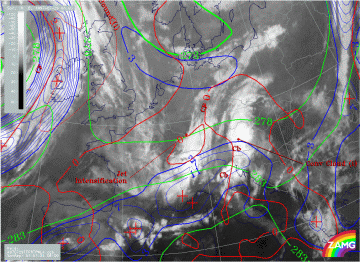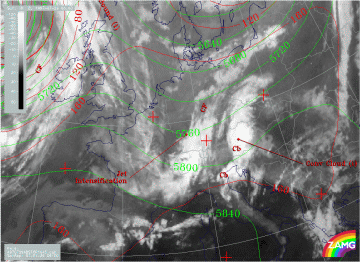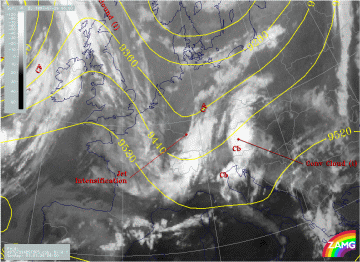29 July 1997 - Frontal Diagnosis
|
29 July 1997/06.00 UTC - Meteosat IR image; blue: thermal front parameter (TFP) 500/850 hPa, green: equivalent thickness 500/850 hPa,
red: temparature advection - WA 1000 hPa; SatRep overlay: names of conceptual models
|
|
The image above shows a combination of numerical parameters typical for front identification:
- Equivalent thickness 500/850 hPa
- Temperature advection (TA) especially warm advection (WA) 500/1000 hPa
- Thermal front parameter (TFP) 500/850 hPa
While these parameters support the frontal character of the cloud band on the western boundary of the image, the two cloud bands in the centre with a north-south orientation are not at all frontal cloud bands. A rather weak thickness gradient crosses the cloud band perpendicularly, WA and CA are rather weak and without any distinct relation to either of the two cloud systems, and the TFP extends in a more west-east direction from the Pyrenees across north Italy to Slovenia and south Austria.
This is a typical situation where the TFP characterises an air mass boundary immediately south of the Alpine mountain ranges separating the warm air mass in the Mediterranean from the colder one north of the Alps. The two north-south oriented cloud bands are to a large extent on the northern side of the air mass boundary and have a different physical background.
|
29 July 1997/06.00 UTC - Meteosat IR image; red: height contours 1000 hPa, green: height contours 500 hPa; SatRep overlay: names of
conceptual models
|
29 July 1997/06.00 UTC - Meteosat IR image; yellow: height contours 300 hPa; SatRep overlay: names of conceptual models
|
The images above show the height contours close to the surface (1000 hPa, red), at 500 hPa (green) and at 300 hPa (yellow). While there is an extended but unstructured high pressure zone at 1000 hPa, the upper levels do show a pronounced trough which becomes even more distinct on the higher surfaces and is clearly related to the rear side of the western of the two cloud bands.
This relationship indicates also that what occurs in the upper levels has an important influence on cloud systems.


